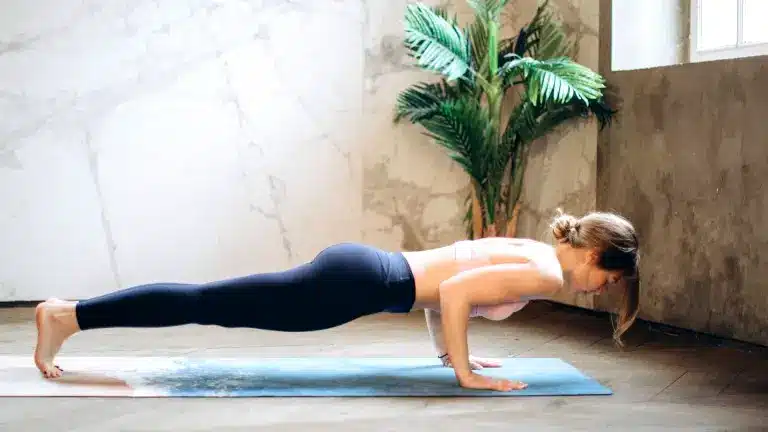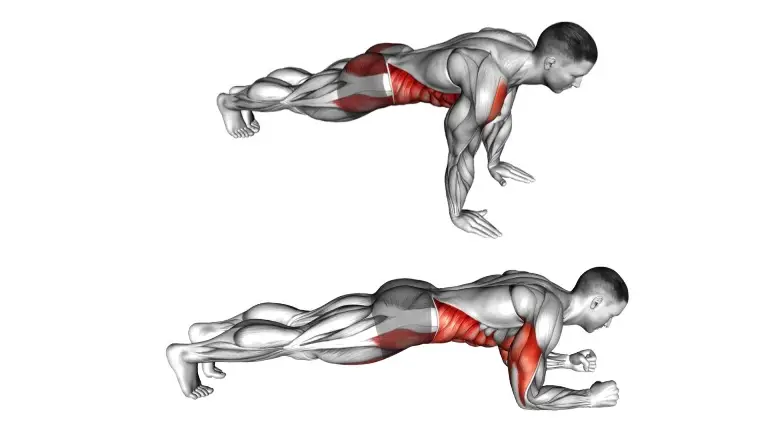Want to take your plank exercise to the next level and work your upper body at the same time? Then must try plank push-ups.
It is a brilliant bodyweight exercise that helps you to develop the strength and stability of your core and upper body.
Plank push-ups are a great way to build strength at home or when you don’t have much time.
In this post, we’ll teach you how to do a proper plank push-up with excellent form. We will also discuss the benefits of plank push-ups, the muscles worked, and the modifications.

- What Is a Plank Push-Up?
- Muscles Worked During Plank Push-up
- How to do Plank Push up
- Tips For Doing Plank Push-Ups
- Benefits of Plank Push-ups
- 1. Strengthen Core Muscles
- 2. Avoid Muscle Imbalances
- 3. Improve Functional Strength
- 4. Burn calories and fat
- 5. Convenience and Versatility
- Push Up plank Exercise Variation
- Plank to Push-Up for Beginners
- Advanced Plank to Push-Up
- Best Alternative to Plank Push-up
- 1. Plank Reach
- 2. Lateral Plank Walk
- Takeaways
- FAQs
- Are plank push-ups good?
- 25 Most Effective Types Of Push-Ups Exercises
What Is a Plank Push-Up?
The Plank Push up — also known as the “plank-to-pushup” is the combination of the two exercises (Plank and Push-up.), that provide the benefits of both.
The plank push-up is simple to do. You alternate between a high plank and a forearm plank with control, then push your body back up one arm at a time.
Core and stabilizer muscles are engaged throughout the movement, which helps build core strength. It is also a proven way to build up your upper body and get stronger.
This is more of a strength-building exercise than a cardio exercise, and it can also help you burn more calories.

Use our free calculator to know your weight loss calories requirement.
Muscles Worked During Plank Push-up
The Plank Push-up position engages a wide range of major muscle groups, making it an effective component for your workout.
- The Primary muscles worked are the Pectoralis, back, and Core including erector spinae, rectus abdominis (abs), and transverse abdominis.
- In addition, the position uses the trapezius (traps), rhomboids, and shoulder muscles, of the upper body, as well as the glutes, quadriceps, and calf of the lower body.

Know More: Side Plank: Benefits, Variations, Muscles used, Tips
How to do Plank Push up
A step-by-step guide on how to do this.
- Lie face down on an exercise mat with your hands should be shoulder-width apart.
- Your knees should be about hip-width apart, your head facing forward, and your palms flat on the floor.
- Start to get in a push-up position, bend your elbows, and rest your weight on your forearms instead of on your hands.
- Keep your core, butt, and quads tight, and avoid arching your back.
- Your body should form a straight line from your shoulders to your ankles.
- Brace your core by contracting your abs as if you were about to be punched in the gut.
- Press your body up into the top position of a push-up by extending your arms one at a time.
- Pause, then reverse the movement and return to your elbows. That’s 1 rep.
- Choose your sets and repetitions based on your ability to maintain good form throughout.
- Begin by performing 3–4 sets of 8–12 reps

Tips For Doing Plank Push-Ups
- Warm up with a full-body loosening exercise, such as jogging or jumping rope, before your workout.
- Set your hands slightly wider than shoulder-width apart for a more stable foundation.
- Keep your body in a straight line from head to toe.
- Breathe regularly throughout the exercise.
- Use an exercise mat under your arms to increase comfort and stability.
- Keep your legs and body straight.
- Avoid letting your hips sag during the exercise
- Squeeze your abs and glutes throughout the movement for stability.
- Move slowly and with control. Avoid just dropping or thrusting your body up and down.
- If full plank push-ups are too difficult, start with your knees on the floor to build strength.
- For increased intensity, place your feet on a bench.
Benefits of Plank Push-ups
There are several important benefits to practicing alternating plank push-ups. It is one of the best exercises for strengthening your core and upper body. When you move, your leg muscles are also worked.
1. Strengthen Core Muscles
When you do push-ups plank, you work your core muscles and gain all the benefits that come with a strong core. In addition, plank push-ups work the whole body.
2. Avoid Muscle Imbalances
Planks push up condition the front and back of the body simultaneously.
When muscles are equally developed on both sides of the body, the result is better posture, increased spinal support, and decreased lower-back pain.
3. Improve Functional Strength
One of the strongest persuasive points for planks is their relevance when it comes to functional movement, which is an essential component of living a healthy life.
4. Burn calories and fat
The Plank to push-ups variation is a combination of strength and cardiovascular exercise.
These plank variations exercises can help you to burn calories and regulate your weight.
5. Convenience and Versatility
Plank push-ups don’t require any equipment and can be done anywhere. This makes them a great exercise for people who don’t have much time or can’t go to the gym often.
To Stay Motivated: 150+ Gym Workout Motivational Quotes To Stay Fit
Push Up plank Exercise Variation
There are several variations of the plank to push up to further work the core muscles and build strength and stability. There are also ways to change it if you are a beginner and advanced.
You can do planks at different levels to suit your fitness level.
Plank to Push-Up for Beginners
If you’re just starting out, perform both the forearm plank and the high plank from your knees. As you build up strength, you’ll be able to perform the full exercise on your toes.
1. Knee Plank Push-Ups (Beginner)
- Ideal for beginners or those with limited upper body strength.
- Performed by keeping the knees on the ground, reducing the load on the arms and upper body.
- Focuses on building strength gradually.
Advanced Plank to Push-Up
To make this exercise more challenging, try adding a push-up at the top before returning to the forearm plank.
1. Diamond Plank Push-Ups
- Hands form a diamond shape (thumbs and index fingers touching).
- Places more emphasis on the triceps and inner chest.
- Known for being more challenging than the standard version.
2. Decline Plank Push-Ups
- Feet are elevated on a bench or step, with hands on the ground.
- Increases the intensity for the upper chest and shoulders.
- Suitable for intermediate to advanced fitness levels.
Best Alternative to Plank Push-up
Before we deep dive into the best plank push-up alternatives. We must not forget that a good alternative will be able to satisfy the following criteria:
- Activate the muscle groups which are trained in the plank push-up.
- Train the core muscle through a longer range of motion.
1. Plank Reach
Plank reach requires is the best alternative to plank push-ups. It improves core stability and balance. This move is a moving forearm plank that forces you to activate your core as you move to different positions.
You’re going to come onto your elbows and find a nice, solid core. From here, you’re going to reach one hand forward, and then alternate.
2. Lateral Plank Walk
The Lateral Plank Walk is a full-body exercise that mainly targets your core and shoulders. Take a walk on the wild side as well, as wild as a plank can get. If you are searching for an alternative to plank push-ups, it is a great option for you.
This move intensely engages your core like a classic plank, but the side-to-side motion works your arms and delts, too. Plus, it’ll challenge your balance and stability.
The faster you “walk,” the more challenging this will be cardiovascular. Slow down if you need to dial down the intensity a bit.
Takeaways
Depending on your current fitness level as well as the duration and intensity of your strength training routine, it may take a few weeks or months to build up to doing plank push-ups.
As you progress, find ways to vary your routine. This provides you with a challenge and trains you to use your body in different ways. It also helps to prevent boredom and plateauing.
FAQs
Are plank push-ups good?
Yes, plank push-ups are good because there are several benefits to practicing them. It builds full-body strength.
One of the best persuading points for planks is their relevance when it comes to functional movement, which is an essential movement to living life.
25 Most Effective Types Of Push-Ups Exercises

Manish brings over 10 years of hands-on experience in weight lifting and fat loss to fitness coaching. He specializes in gym-based training and has a lot of knowledge about exercise, lifting technique, biomechanics, and more.
Through “Fit Life Regime,” he generously shares the insights he’s gained over a decade in the field. His goal is to equip others with the knowledge to start their own fitness journey.
